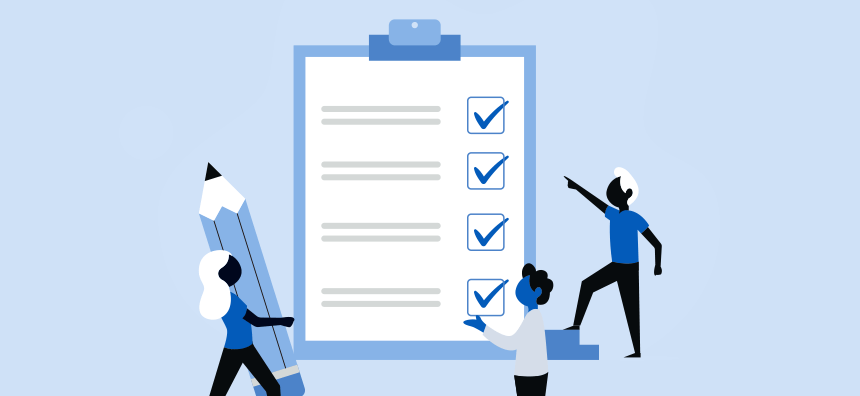
Click the button to start reading
A Comprehensive Project Closure Checklist – Your Guide To Success in Project Management
When it comes to project management, a project closure checklist is important to give guidance and protect the quality and caliber of your present and future projects. Some may believe that simply finishing the project is the final step of the process and the most important aspect of a project is the work put into it to make it successful. While that certainly is important, how a project is closed out can have a significant impact on how it performs, the satisfaction of your clients, and the overall success of your company altogether.
So, let’s define a project closure plan, and discuss why it can be a valuable addition to your project timeline.

What Is Project Closure?
Project closure can be defined as a system of steps designed by the management team aimed to support the final stages of a project. Simply put, it’s the closing phase of a well-planned project.
When you begin a project, it’s important to include project closure into your working timeline and schedule— especially when a project is being billed based on the total hours needed to complete it. Project closure takes time, so it’s vital that you account for it before you begin.
To help ensure a smooth transition through your project closure, include it in your project schedule. This will help you make sure it’s not forgotten as the project continues through its various stages. To make this even more effective include the closure checklist (or link the document of it) in the schedule notes. This will give your team access to the final steps before they begin, allowing them to use the checklist to guide their work, including task completion, testing, documentation, and organization.

Top 4 Benefits Of Having A Project Closure Plan
The benefits of including a project closure process in your organization can vary based on how intricate you want the process to be. While a more detailed project closure may seem like it would provide more benefits, this may not always be true. It’s important to consider your timeline and the most valuable aspects of your project. This will help you create a project closure process that is best suited for your project, and yield the best benefits.
Here are the benefits of including a project closure checklist and plan:
- Promotes Organization Throughout The Project Lifetime
A well-designed project closure plan that is created and shared prior to the work beginning, will help your staff pre-plan essential steps they must take. This would include their organizational systems to keep all necessary documents stored properly, payments to be made within their scheduled bounds, and reports being generated to support the closure checklist. - Enhanced Learning For Future Projects
One of the main aspects of project closure is documenting issues the project faced, along with their solutions. These can be discussed following the completion of the project to help influence updated procedures for the betterment of future projects. - Provides A Safety Net
Project closures include final rounds of testing and allocate time for the team to go through the project to flush out any areas of concern. Implementing a strict review system during the final phase of the project helps you protect the integrity of the project before the deliverables are released to the client. - Increases The Quality Of Your Projects
Including a project closure process helps you consistently produce high-caliber work for your clients. This leads to better engagement, higher commitment, and better retention of clientele. In many cases, this can make your company an industry leader, creating a more valuable service that leads to an influx of new, more exclusive projects.

When Does The Project Closure Process Begin?
A project being finalized isn’t the end of a project timeline. In fact, this is the signal for your team to enter into their last phase. Often, a project team moves into its closure process when a project is presumed finished and is ready to be handed off. At this time, management will begin working their way down their project closure checklist, formally beginning the final tests, organizing reports, settling invoices, and releasing resources no longer needed.
What Happens If You Don’t Have A Project Closeout Plan?
Project closeout plans play a vital role in a company’s growth, workplace culture, and overall company success. Failing to include a closeout plan can put your team and final project at risk in a number of ways, such as:
- Decreasing Learning Opportunities
A large part of any project closure is reviewing the issues the project experienced, along with the steps taken to mitigate them. These provide valuable learning opportunities for your team, helping them make more informed decisions in future projects. - Higher Risk Of Errors
During project closeout, the team puts the project through final testing to ensure they are handing off a quality product to their customer. If these tests are not properly completed or missed altogether, you run the risk of overlooking project errors you would have been able to mitigate prior to handoff. - Reduced Employee Morale
One of the final aspects of project closure is employee gratitude and recognition. This step is one of the most valuable ones to include in your plan and will have a huge effect on your workplace culture and team morale. If you skip this step or glaze over it, it can quickly deteriorate your team’s production, quality of work, and satisfaction within the workplace. - Less Organization
Organization in the workplace is a vital aspect of any strong workplace. Without strong organizational systems, you may miss collecting, reviewing, and closing out vital documents connected to the project. These documents are especially important when they are connected to any financial aspect of the project, and if not closed out appropriately, can leave you open to liabilities. - Exceed Project Timeline
When project closure is included in the timeline, it helps keep your project on schedule by ensuring all vital aspects are accounted for during the closing stage. If this is not done, you risk your project running over its expected timeline. This creates a scenario where you and your team are crunching to get the essential final tasks completed without the time allocated to do so. It may even be too late for fast-tracking. - Increased Workplace Stress
When your staff feel rushed to complete a project or are not allotted the appropriate time to complete a project to the expected caliber, it creates a more stressful work environment. High demands mixed with unrealistic timelines can be detrimental to the health of your team. Implementing a well-planned closure process mitigates that stress.
Now that you have a good understanding of why project closure plans are so important, let’s look at how you can set it up for your next project!

Project Closure Process – Stages & Steps
How you design your project closure checklist will reflect your management style and the processes you have in place throughout the lifetime of the project. Each step that is typically included in a project closure process will fall into one of three stages:
- Technical Processes
- Learning Processes
- Team Morale Processes
When designing your project closure process, there are some vital aspects to include to help promote a highly successful, quality project. Let’s break them down into their individual stages.

Technical Processes
This stage includes processes that are aimed to complete and polish the final project, and relate directly to project items themselves. There are four main steps you should include in this stage:
- Review The Project Outline And Expectations
This signals the beginning of the project closure process. In this step, meet with your team and go through each aspect of the project, verifying that everything has been completed. Look at tasks individually and have the corresponding person verify they’ve been completed, and sign off on their work. This serves three distinct purposes. First, it ensures the project has met the set of expectations assigned to it during the planning phase. Secondly, it gives everyone an opportunity to make any final adjustments to the project or highlight any aspects that have gone unmet. Lastly, it solidifies accountability and professional responsibility throughout your team when they sign off on their individual tasks. - Run Final Product Tests
Before you officially hand the project off to the client, you want to take the necessary steps to ensure it will perform as expected. Take time to test each individual aspect of the project as needed, and manage any issues that are flagged. After completing your final tests, complete detailed functionality reports to back the project up once it’s been handed off. This will help you feel confident that you’re providing a high-caliber project to your client. - Provide Deliverables
Once you’ve completed all tests and are ready to hand the project off, gather all necessary deliverables to be reviewed by the client. Verify with the client that you’ve met the project expectations and have them sign off on the final product you’ve created for them. - Finalize All Project Documentation
In this step, you’ll need to go through all the documents that are connected to the project. This may include things like budget approvals, contracts, issue and solution logs, invoices, and resource funding and allotment. Verify that all documentation has been signed by the required authorities and is ready to be closed out now that the project has been handed over to the client. Completing and closing all documents associated with the project, finalizes all contractual obligations, and serves as binding recognition of the completion and handoff of the project.

Learning Processes
The steps you take after a project has been wrapped up will prove valuable to the updating of current processes and the growth of your team. Many projects will provide insights into its strongest and weakest areas. These provide critical learning opportunities for both you and your team. This learning is usually done by including two important steps:
- Reflect On The Project
When you’ve finalized the project, meet with your team to review its outcome and the processes involved in meeting its expectations. Consider things like:“Did the project go as planned?”
“Did it turn out how you expected?”
“How could you have made the process more efficient?”
“What are some of the lessons you learned throughout the course of the project creation?”
“How could these lessons influence your next project?”The answers to these questions will help you make a list of some of the important lessons this project taught you. Pose these questions to your team in an anonymous questionnaire to get their thoughts on it as well. Keeping it anonymous will help ensure the answers are honest and accurately reflect your employee’s experience throughout the project.
- Document Essential Learning Points
Once you’ve taken time to consider the learning opportunities experienced during this project, it’s important to make formal documentation of them. This will ensure they can be used to help improve policies and procedures for future projects.During this process, host a project closure meeting and include a Q&A section. Ensure strong meeting notes are taken and include them in the learning documentation. Encourage your team to openly discuss the learning opportunities that have been brought forward from the previous step. As a team, brainstorm how these lessons can influence future projects and if they can benefit certain types of project tasks commonly seen. During this meeting, set time aside to discuss the struggles the project faced, and how they were overcome.
Documenting the important learning points discovered each time you complete this stage of a project will help you create more efficient systems for each future project. Additionally, you’ll be able to develop procedures that reflect the individual strengths of your team while planning for additional support systems for weaker areas.

Team Morale Processes
Team morale is the most influential aspect of any project. How well your team functions together, and how well they move through a project is a direct reflection of you as a project manager. This is why including team morale processes at the end of every project are essential.
To effectively maintain and boost positive team morale, you’ll need to include three valuable steps in your project closure process.
- Recognize Strengths And Exceptional Work
In this step, show your gratitude for your team’s role in making this project a success, and thank them for all of their work. Highlight the progress your team has made. This could be their inner workings, their increased project success, or their progress towards a shared goal. Recognizing the team as a whole helps reinforce that the successes found within are for everyone, which can aid in stronger bonds being formed throughout the team.
Following this, it’s important to recognize the individual goals and growth of your team members. Provide affirmation to those members who completed exceptional work, and who demonstrated strong respect and support for their team members. This will encourage each member of your team to meet their individual goals, and recognize the range of talent within the team.
- Hold Individual Accountability Meetings
In these meetings, review each person’s deliverables, productivity, and discuss their individual experiences throughout the project. This step is more than just reviewing an employee’s output and holding them accountable for their ability to meet or exceed their expectations. These meetings go beyond that and should be used to connect with your staff and foster their individual success within the company.
Use these meetings to highlight the strengths you’ve witnessed in that person. Take time to discuss long-term goals and work alongside them to create success plans for them. Brainstorm how you can help them achieve their goals, and the resources they would need to do so. Ask them how you could have supported them better during this project and how you can help them in the future. Use this information to help you grow as a manager, while also creating a more supportive atmosphere for your team altogether.
- Celebrate The Closure Of The Project As A Team
Celebrating with your team each time a project comes to an end is an essential aspect of building a strong rapport. This will let them share in the success their work brought, and reaffirm to your team that you recognize their hard work. By celebrating with them, you are also showing them that you view yourself as part of the team, and not just their manager, which creates higher levels of respect and team responsibility. Celebrating a successful project also helps build strong colleague relationships which benefits future projects and aids in future collaboration between members.
This final act of closure will send the project off on a positive note, setting your team up for success in their next project.

Your Comprehensive Project Closeout Checklist
While the aspects of your project closure checklist may vary, we’ve compiled a comprehensive list of items to include in your next closure plan. These will help you create a strong set of processes to support your next project.
- Review your project (in comparison to outline and expectations)
- Get individual signatures on team deliverables
- Run final tests to flush out any errors
- Create functionality reports from project testing
- Respond to any red flags discovered during testing
- Collect final deliverables
- Create client invoice
- Hand-off deliverables
- Get the client to verify the deliverables and their contents
- Have the client sign off on the project
- Closeout any project documentation
- Project contracts
- Resource allocation
- Budget approvals
- Contractor fees
- Team salaries
- Issue logs
- etc.
- Hold project closure meeting
- Complete a Q&A including all team members
- Create learning documents
- Recognize exceptional work done by your team
- Set accountability reviews & meetings
- Celebrate as a team!
Conclusion
While a project can find success simply through being completed well, the addition of a project closure plan and checklist can be a strong addition to your next project. With a well-designed closeout process, you’ll be better able to provide top-tier projects that your clients can rely on, establish yourself as a leader in your industry, and foster a highly supportive and healthy work atmosphere.
















